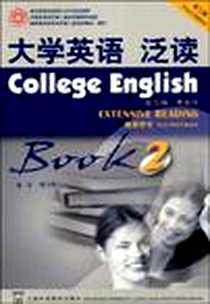《大学英语泛读2教师用书(第三版)》
《大学英语泛读2教师用书(第三版)》
出版时间:2006-6
出版社:上海外教
作者:解又明
页数:128
字数:214000
《大学英语泛读2教师用书(第三版)》前言[E]
《大学英语》是遵照1986年国家教委审定的《大学英语教学大纲(文理科本科用)》编写的一套系列教材,分精读、泛读、听说、快速阅读和语法与练习五种教程,由全国六所重点大学合作编写。教材于1986年出版试用本,1992年出版正式本,并于同年9月荣获全国高等学校第二届优秀教材特等奖,以及国家教委高等学校第二届优秀教材一等奖。
1998年,在广泛征求意见的基础上,《大学英语》系列教材根据《大学英语教学大纲(高等学校本科用)》进行了第一次修订。修订本更加注意文、理、工、农、医等各科的通用性,力求给学生打好“宽、厚、牢”的语言基础。
为了推进大学英语教学改革,适应社会各界对大学生英语能力的要求,教育部于2004年颁布了《大学英语课程教学要求(试行)》(以下简称《课程要求》,)。遵照《课程要求》对大学英语提出的教学目标,即“培养学生的英语综合应用能力”,编者于2004年决定对教材进行第二次修订,以满足新时期国家和社会对人才培养的需要。
本次修订原则:
1.教材的定位不变。《大学英语》是综合教育型(English for integrative purposes)而非特殊目的型(English for specific purposes)的教材,旨在帮助大学本科各专业学生进一步打下扎实的语言基础。
2.选材原则不变。正因为《大学英语》是综合教育型的,选材必须做到题材广泛,体裁多样,语言规范,有利于打好语言基础。选材遵循三性原则,即趣味性、知识性、可思性,以激发学生学习英语的兴趣。
3.在更新课文时注意经典性与时代性的融合,科普性与文学性的融合,使选文内容经得起时间考验,文字经得起反复咀嚼。这两个融合是教材可教性与可学性的保证,也是教材生命力之所在。
4.本次修订按照《课程要求》所提出的培养“英语综合应用能力”这一目标,着重考虑增强听与说的训练,提高听与说尤其是说的要求。
《大学英语泛读2教师用书(第三版)》内容概要[E]
《大学英语》自1986年问世以来,为适应教学形势的变化,几经修改,于1992年出版正式本,并于1997年进行了修订。这套教材使用了近20年,受到使用院校的广泛欢迎,曾先后获国家级奖项它的生命力在于与时俱进,不断更新,不断完善。
本书是《大学英语》(第三版)泛读教程第一册教师用书,按课文顺序编写,每册三十课。在这次再修订中,考虑到使用本教程教师的方便,在原来的基础上增加或删改了一些内容。修订后的每课内容包括:1)背景知识或课文提要:2)课堂教学提示;3)供熟记模仿的句型;4)有些和课文内容有关的彦语,供学生背诵;5)练习答案。教师可根据不同程序的教学对象和具体课时安排灵活使用。每五个单元后还配有一套试题,供教师测试时使用。
《大学英语泛读2教师用书(第三版)》书籍目录[E]
`
《大学英语泛读2教师用书(第三版)》章节摘录[E]
1.This essay deals with a subject with which the students should be very familiar: goodmanners. The teacher may begin by asking the students to give some examples in theirdaily life to show what good manners and what ill manners are.(hold the door open for those who come next; give your seat to an old lady on the bus;say “thank you” to the person who tells you the direction you have asked for; be ontime for an appointment; ask permission before you smoke if several people are pre-sent; look at your watch from time to time when someone is talking to you; talk at thetop of your voice on the bus; jump the queue; tap your pencil on the desk in thereadingroom; keep silent when you are spoken to; make a scene in public places; be cu-rious about peoples private life, their incomes, or their ages;...)
2.This passage is comparatively long and there are many new words in it, but you can tellthe students that they do not have to understand every word. Encourage them to readfor the general sense. The following are the main points of this text which may helpthem to understand the passage fully.
1)Part One (from para. 1 to para. 3)Children are taught good manners so that when they are older they will show respectand consideration for other people. Though ideas about good manners vary fromcountry to country, people often judge a person according to how he or she behaves.
2)Part Two (from para. 4 to para. 6)Children in Britain and America are frequently told to say “please” and“thankyou”. People generally say “please” whenever they ask for something and“thankyou” when somebody has given them something or done something for them.